 Image search results - "treasure" Image search results - "treasure" |

Road to Himeji Castle. From Himeji Station, the main road leads to the castle which can be seen in the distance.
|
|

Road to Inuyama Castle
|
|

Road to Himeji Castle. Otemae Boulevard (Symbol Road). 大手前通り
|
|

Kiso River with Inuyama Castle in the distance
|
|

Uchibori Inner Moat
|
|

Inuyama Castle
|
|

Castle moat
|
|

Inuyama Castle
|
|

Path to Otemon Gate, the main gate to the castle. 大手門
|
|

Haritsuna Shrine
|
|

Otemon Gate, Main gate to castle. Reconstructed in 1937. 大手門
|
|

Sanko Inari ShrineThe shrine provides a short cut to the castle.
|
|

World Heritage Site marker. 世界遺産 姫路城
|
|

Steps to castle gate
|
|

World Heritage Site marker. 世界遺産 姫路城
|
|

Steps to castle gate
|
|

San no Maru. This area is ringed by cherry trees. 三の丸広場
|
|

Reconstructed Honmaru Gate
|
|

A stone's throw from Chojuji Temple, Jorakuji Temple (est. 708) of the Tendai Buddhist Sect boasts two National Treasures with its main hall and three-story pagoda. It is one of the Konan Sanzan Temple Trio accessible by bus from JR Ishibe Station.In the deep-green forest, you can see part of the pagoda's roof.
|
|

Special Historical Place marker
|
|

Inuyama Castle tower
|
|

San no Maru cherry trees. The stone marker says that Himeji Castle is one of Japan's 100 Best Cherry Blossom Sites.
|
|

Castle tower
|
|

Castle view from San no Maru.
|
|

Inuyama CastleNational Treasure
|
|

Main castle tower (donjon), called Tenshu. 大天守
|
|

Castle tower entrance
|
|

Himeji Castle tower, a National Treasure. 大天守
|
|

Inside entrance
|
|

Castle tower closeup. 大天守
|
|

More stairs
|
|

Castle tower, a National Treasure. 大天守
|
|
|
|
|

Very steep
|
|

Castle ticket office and entrance. Admission is 600 yen for adults. Hours are 9:00 a.m. to 4:00 p.m. (September through May) or 9:00 a.m. to 5:00 p.m.(June through August).
|
|

Ninomaru Palace entrance, National Treasure 二之丸御殿
|
|
|

Path to Hishi Gate. 菱門
|
|

Palace entrance roof
|
|

Inside castle tower
|
|

In the deep-green forest, you can see part of the pagoda's roof. You can walk to Jorakuji (means "Constant Comfort Temple") from Chojuji Temple. From Ishibe Station, best to take a bus to Chojuji first, then walk downhill to Jorakuji. Entra
|
|

Hishi Gate, Important Cultural Property. Pass though this large gate to proceed to the Ni no Maru compound. 菱門
|
|

Ninomaru Palace side view facing the garden. National Treasure
|
|
|
|

View from the right of Hishi Gate
|
|

National Treasure
|
|
|

三経院 National Treasure
|
|

View from the right of Hishi Gate
|
|

Ninomaru Palace side view facing the garden.
|
|

Top floorThe top floor was called the Koran Room.
高欄の間
|
|

Ni no Maru. After passing through Hishi Gate, this is what you see.
|
|

Ninomaru Garden
|
|

Portraits of castle lords and owners on top floorEleven generations of the Naruse Clan are shown here.
|
|
|
|
|

Ninomaru Garden
|
|
|

Five-Story Pagoda and Kondo Hall, National Treasures 五重塔 金堂
|
|

Sangoku Moat in Ni no Maru, 三国堀
|
|

Castle map
|
|

Top floor verandaThe fence is quite low and anyone can easily fall over...
|
|
|

I-no-mon Gate (Important Cultural Asset) いの門
|
|

East Bridge to Honmaru and Honmaru Yagura-mon Gate
|
|

View of Kiso River
|
|

Goju-no-To (Five-Story Pagoda), National Treasure, Horyuji. The size of the roof gets smaller toward the top of the structure. 五重塔 仏舎利
|
|

Ro-no-mon Gate (Important Cultural Asset) ろの門
|
|

Honmaru PalaceImportant Cultural Property
本丸御殿
|
|

Veranda
|
|

Horyuji Goju-no-To (Five-Story Pagoda) National Treasure. Houses a few bones of Shakyamuni Buddha. 五重塔
|
|

Path to Ha-no-mon Gate はの門
|
|

Foundation of castle tower天守閣跡
|
|

View of castle grounds
|
|

The Five-Story pagoda has a thick wooden pillar in the center going from the bottom to the top. Only the top part of the building is in contact with the central pillar and works to counterbalance earthquake swaying.
|
|

Path to Ni-no-mon Gate
|
|

Top of castle tower foundation天守閣跡
|
|

Kiso River
|
|

You can enter or see inside the buildings, but no photography is allowed inside.
|
|

San-mon Gate 山門 MAP
|
|

Ni-no-mon Gate (Important Cultural Asset) にの門
|
|

Top of castle tower foundation天守閣跡
|
|

Inuyama Castle roof
|
|

Daikodo Hall and Five-Story Pagoda, National Treasures 五重塔
|
|

Inside Ni-no-mon Gate. A bottleneck gate designed so not many enemy soldiers can pass through at one time.
|
|

Castle tower foundation天守閣跡
|
|
|
|
|

Ho-no-mon Gate (lower left)
|
|

Mizu-no-ichi Gate, Important Cultural Property.
|
|

Mizu-no-ni Gate, Important Cultural Property
|
|

Mizu-no-san Gate
|
|

Castle roof underside
|
|

Honmaru Palace as seen from the castle tower foundationImportant Cultural Property
|
|
|
|
|

Storehouse
|
|

Honmaru PalaceImportant Cultural Property
|
|
|
|
|

Koshi no Kuruwa storehouse for rice and salt
|
|

Moat between Ninomaru (left) and Honmaru (right)East Bridge in the distance.
|
|
|
|
|

Inside storehouse
|
|

Ninomaru Kita Otemon GateImportant Cultural Property
二之丸北大手門
|
|

Castle photo exhibition
|
|
|
|

Family crest on roof tiles. The family crest of the resident warlords who repaired the castle remain on the roof.
|
|

Warehouse wall
|
|
|

Horyuji temple Kondo Main Hall, the world's oldest wooden building at 1,300 years old. National Treasure 金堂
|
|

The family crest of the resident warlords who repaired the castle are displayed. The warlords include Hashiba (later Toyotomi) Hideyoshi, Ikeda Terumasa, Honda Tadamasa, Matsudaira Tadaaki, Matsudaira Naomoto, Sakakibara Tadatsugu, and Sakai Tadazumi.
|
|

Tonan-sumi Turret from the street
|
|
|

Kondo Main Hall, National Treasure and Horyuji's most important building. However, on January 26, 1949, much of the first floor was destroyed by accidental fire. 金堂
|
|

The family crest of the resident warlords who repaired the castle remain on the roof.
|
|
|

Kondo Main Hall houses 13 Buddha statues. 金堂
|
|

Koshi Kuruwa storehouse (Waist Quarter) for salt and rice.
|
|
|

Kondo Main Hall, National Treasure. It has some Chinese design elements. 金堂
|
|

Gate guardian (left side)In the San-mon Gate
|
|

Inside storehouse
|
|
|

Kondo Main Hall, National Treasure 金堂
|
|

He-no-mon Gate への門
|
|

Lord's Room (Jodan no Ma)This room was used by the castle lord.
|
|

Kondo Main Hall, National Treasure 金堂
|
|

View from He-no-mon Gate
|
|

O-sugisama Sacred Cedar TreeThis tree existed even before the castle was built over 650 years ago. It stood 24 meters tall, higher than the castle tower. It absorbed hits by lightning in place of the castle and also protected the castle tower from high winds. The tree then came to be worshipped as castle guardian.
The tree was severely damaged during the Ise-wan typhoon in 1959, and died in 1965.
|
|
|
|

Chi-no-mon Gate in the distance. On the left partially hidden is To-no-ichi Gate. ちの門
|
|

Foundation of the Nana Magari-mon Gate
|
|
|

To-no-ichi Gate との一問
|
|

Reconstructed turret永勝庵
|
|
|

One end of To-no-ichi Gate
|
|
|
|

To Daikōdō Hall
|
|

View of castle tower from Chi-no-mon Gate
|
|

He-no-mon Gate in the distance. As seen from Chi-no-mon Gate.
|
|

Chi-no-mon Gate (after passing through)
|
|

Well Turret sign. The turret is to defend the rear of the castle. It has three rooms, one of which has a 16-meter deep well. 井郭櫓
|
|

Gate guardian (right side)In the San-mon Gate
|
|

Well Turret. The well is 16 meters deep with water 1 meter deep.
|
|

Chūmon Gate, National Treasure 中門
|
|

Bizen Gate entrance to Honmaru, also called Bizen-maru. Notice the coffin stone on the right of the gate. (Important Cultural Property) 備前門
|
|

Chūmon Gate, National Treasure 中門
|
|

Stone coffins at Bizen Gate. Due to a shortage of stones during the castle's construction, many stone coffins unearthed from the tumulus on the hill of the castle were used in the rock walls. The stone coffins were replaced by real stones during the cDue to a shortage of stones during the castle's construction, many stone coffins unearthed from the tumulus on the hill of the castle were used in the rock walls. The stone coffins were replaced by real stones during the castle restoration in the 1960s.
|
|

Even the corridor is a National Treasure. Has about 150 wooden pillars. 西院伽藍の廻廊
|
|

"Sama" hole for dropping stones, throwing spears, etc.
|
|

Chūmon Gate and Kondo Hall
|
|

Castle tower viewed from Bizen Maru (Honmaru). 大天守
|
|

Corridor and Chūmon Gate 西院伽藍の廻廊
|
|

Castle tower viewed from Bizen Maru (Honmaru) 大天守
|
|

National Treasure
|
|

Castle tower stone foundation
|
|
|
|

Castle tower 大天守
|
|

Path to castle tower entrance
|
|

Path to temple
|
|

Mizu-no-go Gate. 水五門
|
|
|

Mizu-no-go Gate door
|
|

Mizu-no-roku Gate
|
|

Inside Mizu-no-roku Gate
|
|

Mizu-no-roku Gate door
|
|

Take off your shoes before entering.
|
|

First flight of stairs
|
|

First floor
|
|
|

Entrance
|
|
|

Sword exhibit
|
|

To second floor
|
|

Weapon racks called bugukake. 武具掛
|
|

Weapon racks called bugukake. 武具掛
|
|

Sign for bugukake weapon racks. Most explanatory signs are also in English.
|
|

Gun racks called bugukake. 武具掛
|
|

Warrior armor displayed on second floor of Himeji Castle tower
|
|
|
|
|
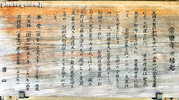
About the templeThe temple was established in 708 as ordered by the emperor.
|
|

View of Honmaru
|
|

To top floor
|
|

Fifth floor
|
|

Top floor of castle tower
|
|

Osakabe Shrine on top floor of Himeji Castle. This shrine was already on the hill before the castle was built. The shrine was moved when the castle was built, but it was brought into the castle after some "curses" occurred.
|
|

View of Honmaru (Bizen Maru), main road to Himeji Station, and Nishi-no-Maru
|
|

Nishi no Maru and Sangoku Moat in foreground
|
|

Nishi no Maru and Hishi Gate (lower right)
|
|

View of Honmaru (Bizen Maru) and shachihoko roof ornament. The shachihoko ornament on the roof ridge guards against fire and natural disasters. Eleven of these are atop the castle.
|
|

View of Honmaru and main road to Himeji Station, Otemae Boulevard (Symbol Road). 大手前通り
|
|

Jorakuji Hondo hall, a National Treasure in Konan, Shiga. The pagoda on the left is also a National Treasure. The original temple burned down in 1360, and rebuilt the same year.
|
|

View of Shirotopia Memorial Park. Site of the Shirotopia Expo held in 1989 to celebrate Himeji city's centennial. シロトピア記念公園
|
|

View looking east
|
|
|

Going back down
|
|

Going down
|
|

Weapons racks called bugukake. 武具掛
|
|
|
|
|
|

Wooden framework of castle tower
|
|

Pagoda and Hondo temple hall
|
|
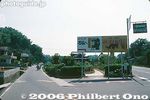
Way to the stone buddhas in Usuki.
|
|

More exhibits
|
|
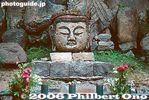
Buddha head before reattachement in 1994. 古園石仏
|
|

Model of castle
|
|
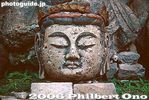
Closeup of Buddha head before reattachment in 1994. Usuki, Oita. 古園石仏
|
|

Path to Harakiri (belly-slitting) Maru on the left or to Ri-no-mon Gate straight ahead.
|
|
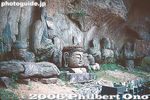
Stone buddhas in Usuki, Oita. 古園石仏
|
|

Harakiki Maru. Square where the samurai committed harakiri or seppuku. The well seen in the upper right may have been where the head was washed. The building on the right was actually a defensive post.
|
|

古園石仏
|
|

Okiku's Well. Subject of a famous ghost story called "Banshu Sara Yashiki," about a castle servant named Okiku.
|
|

Stone buddhas, Usuki, Oita.
|
|

Nu-no-mon Gate (Important Cultural Property). This is the way out.
|
|
|
|
|
|

Stone buddha enclosed by a building. 山王山石仏
|
|

Hondo temple hall
|
|

Hondo temple hall
|
|

Entrance to temple hallInside are statues of gods and Buddhas designated as Important Cultural Properties. One of them was stolen, so there are security cameras inside the temple. Photography is also forbidden.
|
|

Temple roof of Jorakuji temple.
|
|

Buddha statue on Chikubushima
|
|

Hondo
|
|
|

3-story pagoda, also a National Treasure
|
|

Built in 1400We cannot enter it.
|
|
|
|

Jorakuji's Three-story pagoda is also a National Treasure Built in 1400.
|
|
|
|
|
|
|
|
|
|
|
|
|
|
|

Kannon stone buddhaThe temple grounds has 33 stone buddhas.
|
|

Kannon stone buddha
|
|

Fall colors
|
|

Temple bell
|
|

Sansho Shrine 三聖神社The shrine is right next to the temple.
|
|

Sansho Shrine
|
|
| 809 files on 4 page(s) |
1 |
 |
|